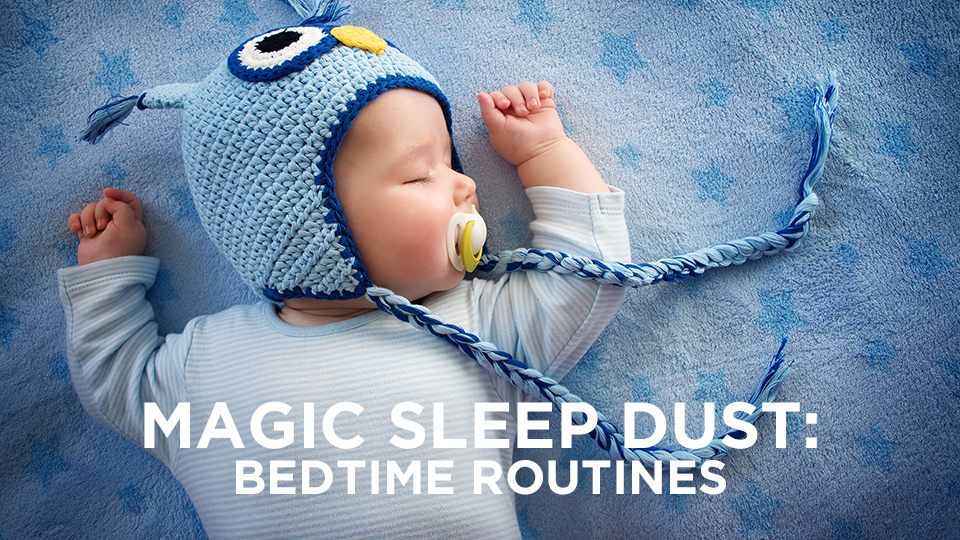
Does bedtime feel like the craziest part of your day? Does your child have unpredictable night wakings? Have you found you’re never sure how long it will take for your little one to get back to sleep? Ever wish you could wave a magic wand and have your night snap into order?
Enter: the magical bedtime routine. Yes, really. Wanna know why?
Making sleep a habit. Routines are super powerful. They allow us to accomplish everything we do during the day: getting dressed, driving to work, making dinner. Our brains rely on the patterns we’ve created. The more often a pattern is repeated, the less the brain needs to rely on the decision-making part of the brain (the prefrontal cortex). What does that mean? Sleep is brain juice. When you’re tired, the brain cuts back from this part of your brain that requires the most juice to run.[1]Muzur, A., Pace-Schott, E. F., & Hobson, J. A. (2002). The prefrontal cortex in sleep. Trends in Cognitive Sciences, 6(11), 475–481. https://doi.org/10.1016/S1364-6613(02)01992-7 That leaves us less able to think as quickly or as clearly. Logic leaves, emotions take over. The routine we’re used to happens as if on its own, because it’s happening in the part of your brain that runs on less brain juice, the basal ganglia.[2]Duhigg, C. (2012). The power of habit : why we do what we do in life and business. New York : Random House. It’s basically an auto-pilot mode. Anyone want a toddler on auto-pilot to bed?
Making sleep predictable. You want your bedtime routine to be 100% predictable. Same activities, same order, everyday. I know that’s a tough order if you’re not wired that way, but this really is important for little ones. Babies learn by patterns. It’s how they make sense of the world and learn how to anticipate what comes next. Toddlers rely on patterns, even though they’ll test you every step of the way! Having the same routine every night is what keeps bedtime on track.
Making sleep enjoyable. Creating a pleasant bedtime routine for your little one reduces bedtime antics. It marks the end of the day and the wind-down toward bed with some special time together. You’re building a pattern that your child will come to easily associate with drifting off to sleep. When you and your child both look forward to their favorite activity at the end of your routine, it gives you bed-momentum. That might mean reading a book, working on a puzzle together, or some snuggles and a lullaby; it’s something that’s special to you. This also builds an important association in your child’s mind: going to sleep is an enjoyable, lovely thing.
Making the transition to sleep. Just like you would probably have a hard time leaving work and going straight to bed, so does your child. A bedtime routine helps your little one transition from the play that IS his/her work into the relaxed state your child needs in order to drift off to sleep.
Making a sleep cue. Don’t miss this: this is really where the power of a bedtime routine shines. When your end-of-the-day pattern is the same each day, your child will connect this routine as the way to fall asleep. Finishing your routine in the place where your little one falls asleep allows them to build that sleepy feeling with that place. In the language of behavioral psychology, this is called stimulus control: a certain environment and feeling triggers a particular behavior, in this case sleep. The more consistently the same stimulus is used for the same behavior, the stronger the connection between the two.
Having a familiar song or good night phrase as your final cue puts the period at the end of the bedtime routine sentence you’ve built. Cues are powerful. For example, my youngest child is three years old; we’ve done the same song at bedtime every night since he was a newborn. Each night I snuggle him on my lap for a few minutes before bed. As soon as I begin to sing his “mommy song,” he’ll climb down and crawl into his bed, snuggling his blanket around him. He knows it’s time to sleep.
Your sleep cues unlock sleep dust power! The sights, sounds, smells, and feeling of the room can all be part of that stimuli that your little one associates with falling asleep. Understanding this is THE MOST CRITICAL part of your bedtime routine. Everyone wakes briefly throughout the night.[3]Halász, P., Terzano, M., Parrino, L., & Bódizs, R. (2004). The nature of arousal in sleep. Journal of Sleep Research, 13(1), 1–23. https://doi.org/10.1111/j.1365-2869.2004.00388.x We rely on those things we associate with sleep at bedtime to continue to help us sleep throughout the night. So if a particular element of what helps you fall asleep is not there or changes during the night, when you come to a light period of sleep you’ll be more likely to wake up fully rather than to resume sleeping. If you fell asleep with your pillow under your head but woke to find it had fallen off the bed, you wouldn’t roll over and keep sleeping–you’d look for your pillow first. Your pillow is a strong sleep cue for you.
You want to make sure that how your little one falls asleep at bedtime remains consistent throughout the night. That means a final feeding might be part of your bedtime routine, but it makes for a poor final sleep cue unless you intend to feed constantly all night long. Your lap is snuggly and wonderful and your child may love to fall asleep there, but it isn’t there for your child all night. It’s not a great cue. Good cues don’t change through the night. The crib or bed becomes a cue, if your little one falls asleep there. White noise that stays on all night is a marvelous cue. A baby who can find her thumb to drift of to sleep: awesome cue. A special lovey for a child who’s old enough (check with your pediatrician, but generally a small sleep object is okay somewhere around 9-12 months): fabulous cue.
When should you start a bedtime routine? You can begin a bedtime routine with your little one as early as 6 weeks of age. Once your baby is smiling in response to your smile, it shows that baby is responding to cues. The need for consistency throughout the night, with your little one falling asleep in a way that stays the same all night long, becomes increasingly important by the time your baby is 3-4 months of age.
Keep reading for part 2 and learn how to make your bedtime routine smooth sailing!
References
